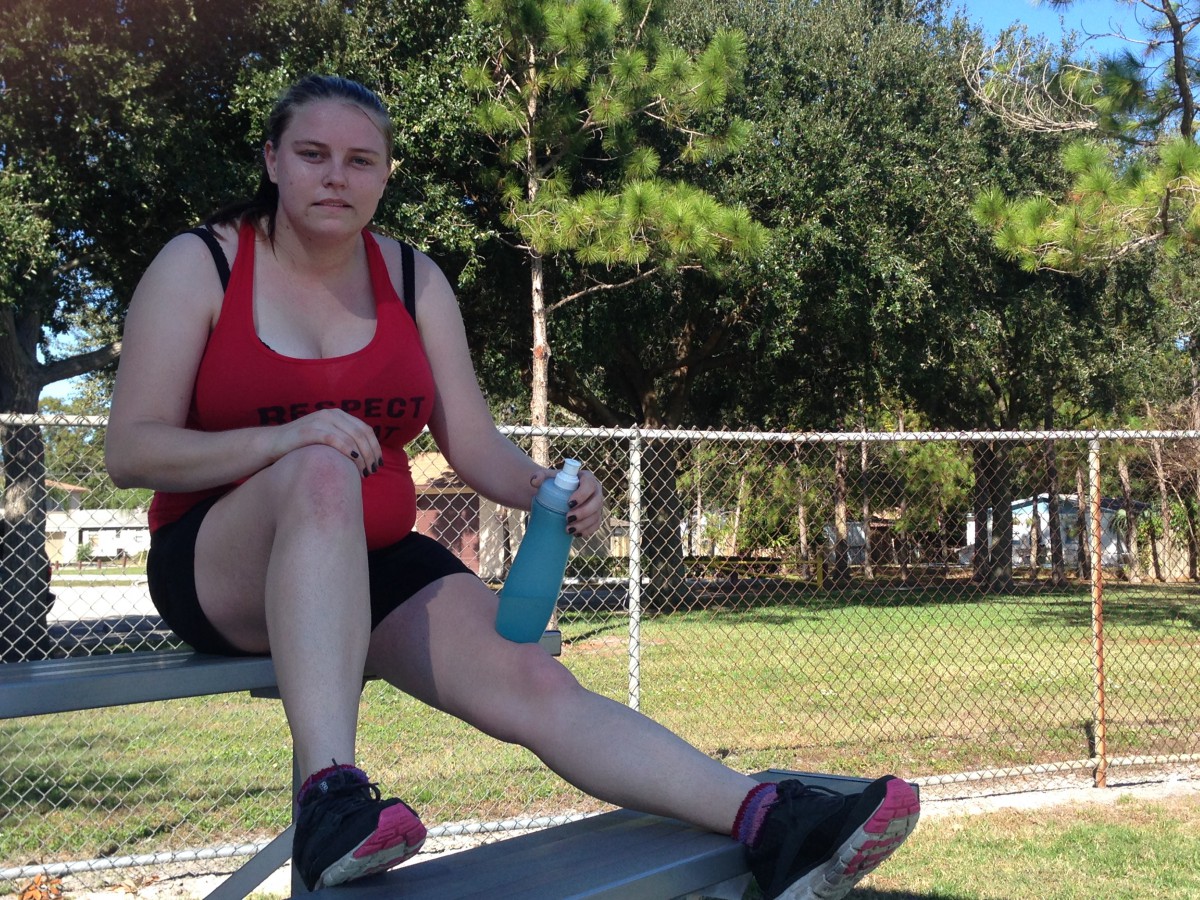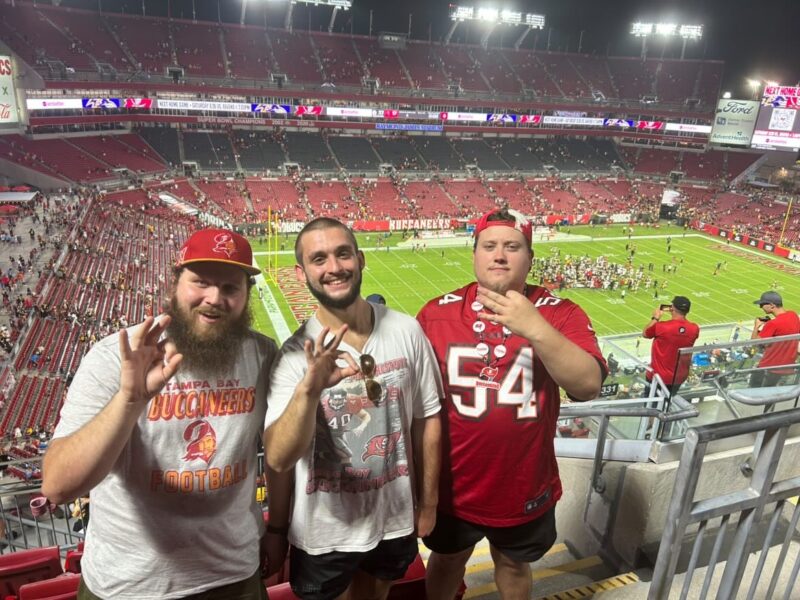Valerie Nyitray, a senior in interdisciplinary social sciences at USF St. Petersburg, bounces a tennis ball off cement walls at Jack Puryear Park in St. Petersburg. She runs agility and blocking drills for 45 minutes.
“I do it to test my reflexes, the quick reactions I need as a lineman,” Nyitray said, bouncing the green ball over her head with a racket.
That’s just Sunday. Nyitray visits the gym up to four days a week.
Nyitray is a defensive lineman and aspiring safety for the upcoming Women’s Indoor Football League team, the Tampa Bay Tornadoes.
It’s too aggressive for lingerie. It’s too rough to go without pads or insurance. The WIFL goes against every cliché set up by the Legends Football League, established by revealing cut-off jerseys and promises to be the “Women of Gridiron.”
Nyitray leads the Tampa Bay team into a new realm for Bay area female athletics.
The inaugural season is just months away.
Ray Blanchette, commissioner for the Women’s Indoor Football League, has fought for female athletes for as long as he can remember. Watching friends and girlfriends growing up, Blanchette found they had fewer athletic outlets than men.
“When there’s one girl who plays football, there’s 10 more girls that play football,” Blanchette said. “Only a few are willing to try it because they’re afraid they’re not going to make it or be looked down on.”
Since starting the league, Blanchette has sought to strengthen the integrity of women’s athletics. He scouted the Legends Football League in Florida to observe the extent of the complaints about the league. It was “just ridiculous.”
“That’s when I found out it wasn’t really a sport,” Blanchette said. “The outcome of the games were predetermined and there were a lot of things wrong with it.”
His success project is the WIFL, fueling the development of eight active teams nationwide. He runs the league out of Lakeland and focuses on growing teams. Divisions sputtered to life over the past year, from Tampa Bay to Washington, D.C.
Blanchette saw the athletes among the pageantry in the LFL. He did not approach a single player.
“The marquee players that have signed with us already have all come to us,” Blanchette said. “We don’t do any type of recruiting. Our fans do our recruiting.”
Tia Knipper, 28, dove into football in the seventh grade. She intended to play with another girlfriend, but when her friend quit, she jumped in with the boys. Her high school in Garrettsville, Ohio, cheered her on with the boys each Friday night.
“In high school, everybody was just so supportive,” Knipper said. “Having that background and those guys supporting me, it really boosted my confidence.”
When her peewee days ended, she found an opportunity in Cleveland with the Crush, a LFL affiliate team. Knipper enjoyed the rush of the game but found disappointment in the lack of athleticism in women’s “professional” football.
“In our league, the girls knew how to play football, but a lot of them were there for their looks,” Knipper said. “You know how to play and they want you. I eventually found out things I didn’t like about the league, and we were treated horribly as players.”
Fans sent Knipper’s stats to the WIFL, a fledgling football league at the time. The league extended her an invitation to play quarterback for the Washington Wildcats. For the first season, she will get paid and be insured.
The positions to play are paid, the athletes for the WIFL maintain full-time jobs outside of their field time and remain dedicated to their previous professions. Knipper works at a veterinary office until spring training. Mixing careers is not a challenge to Knipper.
“I work with animals, so that’s kind of a workout in itself,” she said. “When I can, I find someone to play catch with.”
Knipper is not shy when it comes to new teammates and her new town.
“Everybody from the previous league, all of my fans are huge supporters of me, and they’ve following me through my transition,” Knipper said. “I’ve met a few of my teammates online and coach Rick Reeder. I’m excited to meet these guys in person and can’t wait.”
Legends Football League, like multiple female football leagues, is subject to scrutiny in the media. “Inside Edition” featured seven ex-players for the Legends Football League, who described their experiences as a “bad boyfriend.”
The Huffington Post published a piece looking into the league. Since 2009’s rebranding from the Lingerie Football League, 12 cities host teams. But women from each team cite concerns for injuries, claiming headaches and misused equipment, such as hockey helmets instead of football helmets.
In 2011, 16 of 26 players for the Toronto Triumph resigned, citing player injuries and safety hazards they felt the league did little to address.
The LFL website states the players on the winning team receive 20 percent of the box office sales as pay, with the losing team receiving 10 percent. But according to the players, this is a system used several years ago, and it didn’t last very long. In the last few years LFL players have not received any type of compensation for playing.
The WIFL provides a set salary but will still require players to have careers outside of the sport to live sustainably.
But things are different in the LFL. Injuries add up, and ex-Seattle Mist quarterback, according to the Toronto Star, is suing for $10,000 of unpaid medical bills.
Valerie Nyitray attended tryouts for the Tampa Breeze before its move to Jacksonville. Her figure, perfect for a lineman position, did not qualify.
“I was too short, and my shoulders were too wide for what they wanted,” Nyitray said. “In looking back at that, I realized that really was a league of looks.”
In May, Nyitray joined fellow Floridian female athletes in Lakeland for WIFL tryouts. She trained alongside professional football players, taking swigs of water and trading jabs with seasoned players from the LFL.
“Those players are prior LFL players that have a huge following and are spokespeople for the team or for the league,” Nyitray said. “I’ve looked into a lot of what NFL players do in the offseason for my position on the defensive line and have been trying to do a lot of that stuff.”
Nyitray placed high in the tryout ranks. Her early experience of flag football in high school prepared her for a potential career as a professional football player.
“What makes this league stand apart from the others is that women are treated as true athletes,” Nyitray said. “We wear full uniforms, we wear full pads, we follow the safety compliance rules of the Ultimate Arena Football League. We’re expected to do all the same things.”
Nyitray was asked to help organize the Tampa Bay Tornados. She has helped guide the selection of teammates and establish ownership. Her time is split between preparing for graduation from USF St. Petersburg in the spring and recruiting and assembling a team for Tampa Bay.
Football for women is an opportunity for change in women’s athletics, Blanchette said.
“One of the things we want to do down the road is to get women’s football into high schools and colleges and give women the option to play before they get out of college so they can come up through the ranks,” he said.
But there won’t be the pageantry and glory of the NFL, he noted. Women will have the opportunities similar to arena football players, to keep the game humble.
“We’re going to be a true professional league,” Blanchette said.
The inaugural season for the Women’s Indoor Football League is set to kickoff early summer 2014.
Photo: Amanda Starling/The Crow’s Nest



